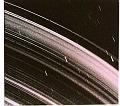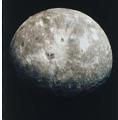URANUS WAS THE FIRST PLANET to be discovered since the use of the telescope. It was discovered by accident, when William Herschet observing from Bath, England, set about remeasuring all the major stars with his 6-in (15-cm) reflector telescope. In 1781 he noticed an unusually bright object in the zodiacal constellation of Gemini. At first he assumed it was a nebula and then a comet, but it moved in a peculiar way. The name of Uranus was suggested by the German astronomer Johann Bode, who proposed that the planet be named after the father of Saturn, in line with established classical traditions. Bode is also famous as the creator of Bode's law-a mathematical formula that predicted roughly where planets should lie. Read some facts about Uranus below, or click here.
William Herschel(1738-1822)
William Herschel was so impressed by a treatise on optics, which described the construction of telescopes, that he wanted to buy his own telescope. He found them too expensive, so in 1773 he decided to start building his own. From that moment on, astronomy became Herschel's passion.
Eccentric Tilt
Uranus spins on an axis that is tilted at an angle of nearly 98° from the plane of its orbit. This means that, compared with all the other planets in the solar system, Uranus is spinning on its side. During its 84-year orbit of the Sun, the north pole of Uranus will have 42 years of continuous, sunny summer, while the south pole has the same length of sunless winter, before they swap seasons. This odd tilt may be the result of a catastrophic collision during the formation of the solar system.
19th Century Model
Because of the odd angle of Uranus's rotational axis, all its known satellites also revolve at right angles to this axis, around Uranus's equator. This fact is demonstrated by an early model, which shows the planet and four of its moons tilted at 98°.This orrery dates from the 19th century when only four of the 27 moons had been discovered.
View from Space
Uranus is a giant planet, four times larger than Earth. The Hubble Space Telescope took these contrasting views in 2004. On the left, Uranus is seen in natural color. It looks blue because of absorption by methane in the atmosphere. The image on the right is false color, which shows bright clouds and hazy bands parallel to the equator.
Airborne Observation of Uranus
The covering of one celestial body by another is known as occultation. A team of scientists observed the occultation of a star by Uranus in 1977 from NASA's Kuiper Airborne Observatory over the Indian Ocean. This was when the faint rings of Uranus were observed for the first time.
Uranus Ring System
While watching the occultation of Uranus in 1977, astronomers noticed that the faint star "blinked on and off" several times at the beginning and end of the occultation. They concluded that Uranus must have a series of faint rings that caused the star to"blink"by blocking off its light as it passed behind them. The Voyager 2 flyby in 1986 uncovered two more rings. The rings of Uranus are thin and dark, made up of particles only about a yard (1 m) across. The broad bands of dust between each ring suggest that the rings are slowly eroding.
Literary Moons
All the satellites of Uranus are named after sprites and spirits drawn from English literature. The American astronomer Gerard P Kuiper (1905-1973) discovered Miranda in 1948. (Miranda and Ariel are characters from William Shakespeare's The Tempest.) It has a landscape unlike any other in the solar system. Miranda seems to be composed of a jumble of large blocks. Scientists have suggested that these were caused by some huge impact during which Miranda was literally blown apart. The pieces drifted back together through gravitational attraction, forming this strange mixture of rock and ice.
Titania
William Herschel discovered Uranus's two largest moons in 1789, naming them Oberon and Titania, the fairy king and queen in William Shakespeare's A Midsummer Night's Dream. The English astronomer William Lassell (1799-1880) discovered Ariel and Umbriel in 1851. Miranda was discovered in 1948. Since then, a further 22 moons have been found.
Facts about Uranus
- Sidereal period 83.8 Earth years
- Temperature at cloud tops -345'F (-210'C)
- Rotational period 17 hr 14 min
- Mean distance from the Sun 1.785 billion miles/2.87 billion km
- Volume (Earth = 1) 67
- Mass (Earth =1) 14.5
- Density (water = 1) 1.29
- Equatorial diameter 31,765 miles/51, 120 km
- Number of satellites 27



